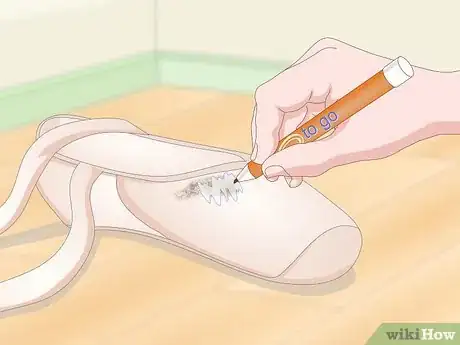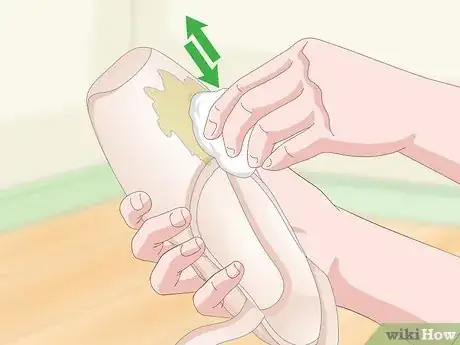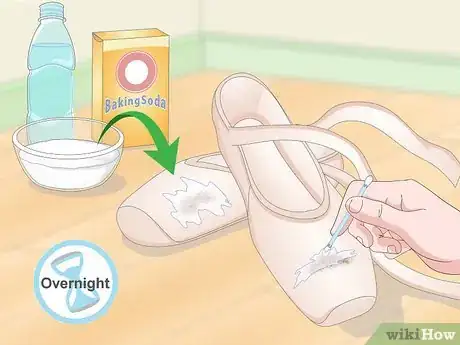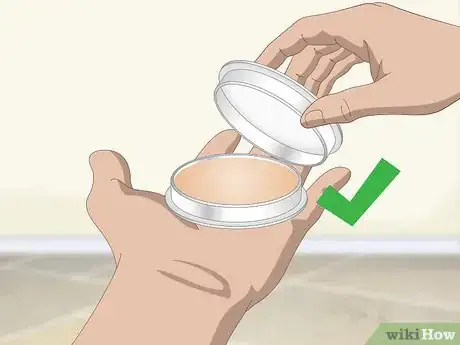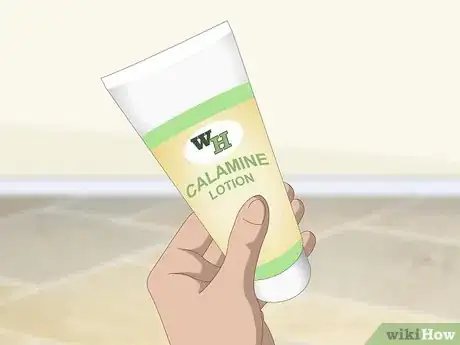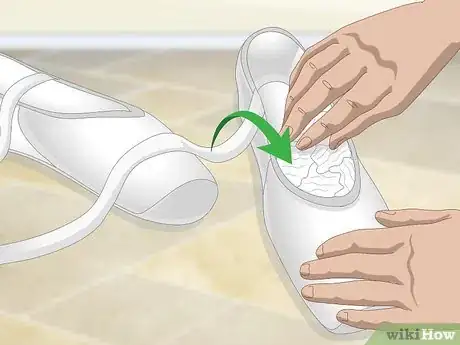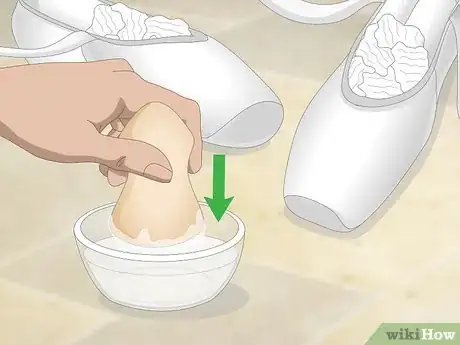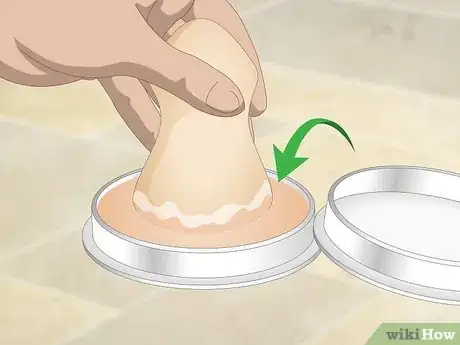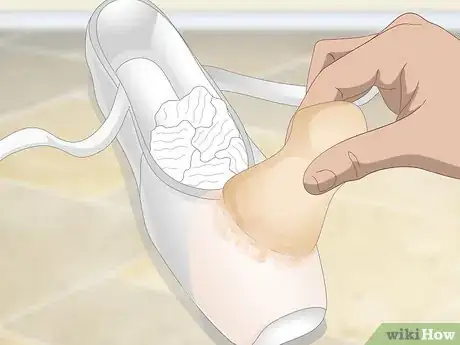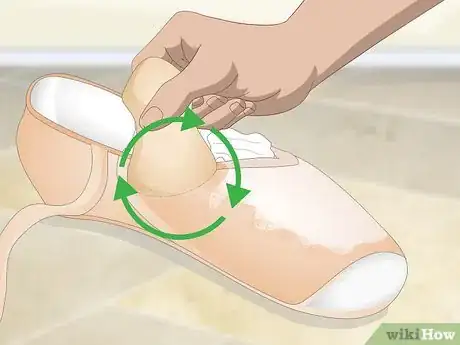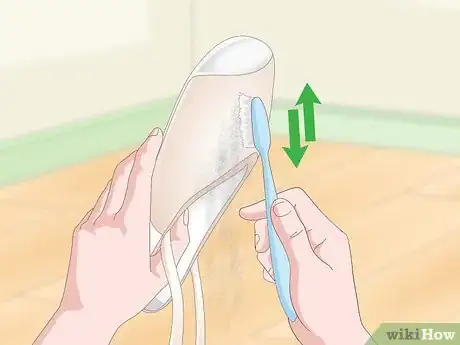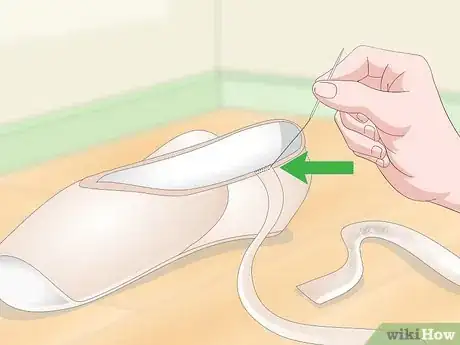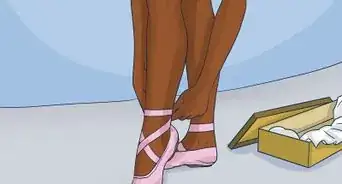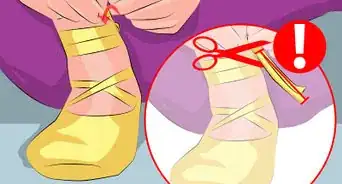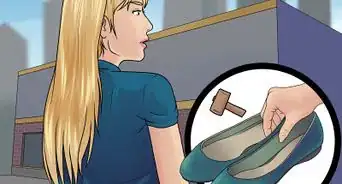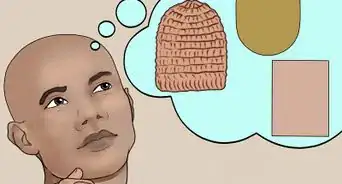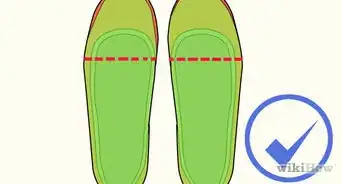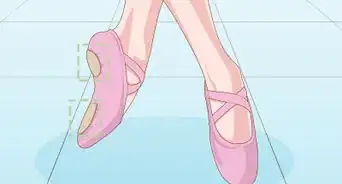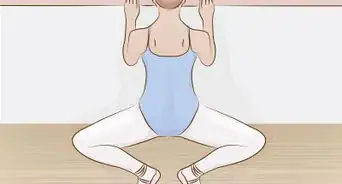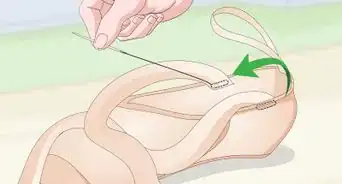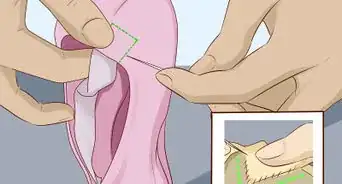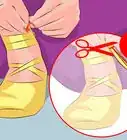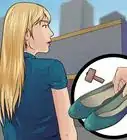This article was co-authored by Geraldine Grace Johns. Geraldine Grace Johns is a Professional Ballerina and the Owner of Grace Ballet in New York and Los Angeles. Geraldine toured through New Zealand, Australia, Japan, and Korea as Jammes in Ken Hill's Original Phantom of the Opera. She has studied with the Royal Academy of Dance in London to become a teacher and taught for the Kudo School of Ballet in Yokohama. Geraldine also ran her own Royal Academy of Dance School in New Zealand before studying at the Neighborhood Playhouse School of the Theatre in New York City. Geraldine was a guest coach and Master Class teacher in Toronto for the Canadian Royal Academy of Dance's Dance Challenge in 2018, 2019, and 2020. She was also a guest coach and Master Class teacher for the USA Royal Academy of Dance Challenge in Long Beach, California in 2019 and 2020. Grace Ballet Los Angeles has won recognition as one of 13 Best Ballet Schools in Los Angeles since opening her school. Geraldine is a contract Practical Teaching Supervisor for the Certificate in Ballet Teaching Studies for the Royal Academy of Dance.
There are 17 references cited in this article, which can be found at the bottom of the page.
This article has been viewed 67,964 times.
If you need to restore a pair of dingy pointe shoes, you have quite a few options for how to do so. To eliminate stains and blemishes, try a simple spot-cleaning process with either laundry detergent or a baking soda paste. For covering up and mattifying your shoes completely, try pancaking them with a few coats of either calamine lotion or water-based cake foundation. And since neat ribbons and elastics contribute to the appearance of your shoes, consider detaching and washing old ribbons and elastics, or totally replacing them, to help make your pointe shoes look like new again.
Steps
Spot-Cleaning Your Shoes
-
1Place a drop of laundry detergent onto dirt or stains. Pick up a small drop of mild laundry detergent using a cotton swab. Then, apply it onto the stained or discolored area.[1]
- This can be done following a stain-removing solution or independently.
-
2Massage the cleaning solution into the stain using a soft washcloth. After dabbing a small amount of laundry detergent or baking soda paste onto the stained area, use a soft washcloth to rub the solution into the satin fabric.[2]
- Try using an old toothbrush or manicure brush instead of a soft cloth to gently scrub away tougher stains.
- Make sure to be careful and delicate with your shoes to not damage them.
Advertisement -
3Apply a stain-removing solution to stubborn stains. If you’re using a stain remover in a to-go pen, dab the end of the pen directly onto the blemish. For a liquid stain-remover, use a cotton swab to apply the solution to the stain.
- Apply the stain-removing solution as soon as possible to prevent it from permanently staining the satin, especially if you notice a food spot or makeup smudge on your pointe shoes.
- Be aware that the bristles may dull down the satin if you rub too hard.
-
4Wipe off the cleaning solution with a damp washcloth after 5 to 20 minutes. Wait between 5 to 20 minutes to allow the solution to work on the stain. Then, add a few drops of water to the corner of a soft washcloth and wring it out to remove the excess moisture. Then gently dab the damp corner of the washcloth into the cleaning solution to lift it off of the stain.[3]
- The washcloth should only be slightly damp, not dripping.
- Allow the cleaned area to dry completely before wearing your pointe shoes.
- Make sure you’ve removed all of the laundry detergent to avoid discoloring the satin.
-
5Try using a paste of baking soda and water for overnight stain-removal. To eliminate tougher stains, mix up a thick paste of 2 parts baking soda with 1 part water in a small bowl.[4] Then, use a cotton swab to apply a small amount to the stained part of the shoe. Allow it to dry into a chalky powder and leave it on overnight. Finally, gently wipe it off with a damp cloth to remove all of the baking soda.
- A mixture of 2 tsp (9.9 mL) of baking soda and 1 tsp (4.9 mL) of water should be sufficient to treat a single stain or spot.
- Feel free to use a baking soda paste after using laundry detergent or on its own.
Pancaking with Foundation or Calamine
-
1Use a water-based cake foundation to achieve the color of your choice. Select a shade that either matches your tights or your skin tone, depending on your studio’s guidelines or your personal preferences.[5] Opt for a water-based foundation instead of a waterproof product, and choose one that comes in a cake or compact rather than a tube or bottle.
- Bring your tights and/or pointe shoes to a makeup store to help you choose the right color.
- Pancaking or matting your pointe shoes is a great way to cover up stains and discoloration.[6]
- If you use waterproof or grease foundation you’d need to set it with powder or else it will stay oily. This can get messy and is unnecessary when there are plenty of great water-based products to choose from.[7]
-
2Opt for calamine lotion as an inexpensive alternative to foundation. You can buy a bottle of calamine lotion at your local drugstore, so it’s useful in a pinch. Pour a quarter-sized dollop from the bottle into a cup to make the application easier.
- If your pointe shoes are a deeper orange color or a saturated pink, dilute the calamine lotion with a few drops of water.[8]
- Some studios desire everyone to pancake their shoes in the same way so that the entire company looks neat and uniform. Calamine lotion can be an easy way to achieve uniformity.
-
3Stuff your pointe shoes with crumpled-up newspaper for support. Bunch up some paper and stuff it into each shoe, making sure the soft sides and heel area are well-supported from behind.[9]
- Alternatively, try using disposable grocery bags or old socks instead of newspaper.
- If you don’t want to stuff the shoe, you’ll just need to slide your hand inside the shoe to hold up the softer parts.
-
4
-
5Dab the moist sponge into the foundation or calamine lotion. Whether you’re using calamine lotion or foundation, load up the end of the applicator sponge with some product.[12]
- You’ll apply 2 coats of the calamine or foundation, so don’t overload the sponge.
-
6Blot the foundation or calamine lotion onto the satin parts of the shoe. Start by dabbing the end of the sponge onto the toe box to cover it with the product. Then move around to the sides, heel, and underside of the shoe until you’ve completed a full first coat. Dab some product onto the drawstring casing and press it deeply into the pleats on the bottom of the shoe.[13]
- A blotting, dabbing motion will give an even layer of coverage without streaks, but you can also spread the product on in a crosswise motion, running in the same direction as the grain of the satin.[14]
- Avoid getting any product on the leather outsole.[15]
- You can pancake the platform of the pointe shoe if you’d like, but keep in mind that it will dry with a different texture. Don’t try this unless you’re confident that you can dance in your shoes with the product there.
-
7Apply a second coat to achieve full coverage, especially over dirty areas. You don’t need to let the product dry before you start adding a second coat. Continue blotting it onto the satin parts of the show using the makeup sponge, picking up more product as needed.
- If your pointe shoes are dark and dirty around the heel area and around the pleats on the underside of the toe box, you can continue with a third coat over these areas.[16]
-
8Allow the foundation or calamine lotion to dry completely. To be safe, allow the shoes to air out overnight. Foundation will usually dry a little faster than calamine lotion, within 1 or 2 hours, but wait until your shoes are completely dry to the touch before wearing them.[17]
- Note that calamine starts out as a more saturated pink but dries lighter.[18]
Freshening up the Satin, Ribbons, and Elastics
-
1Brush the satin using a soft bristle brush to remove dust. An old toothbrush, manicure brush, or even a garment brush can be suitable. Swipe the bristles swiftly but lightly over the satin, working in a crosswise direction to match the grain of the satin. Focus on brushing the underside of the shoe, where it comes into contact with the floor, with close attention to the pleats.
- This should help lift out some of the dust and debris from between the fibers, which can improve the appearance of your shoes.
- Don’t apply too much pressure since the brush bristles may damage the satin.
-
2Trim frayed satin around the platform using manicure scissors. Hold the frayed pieces of satin out and carefully snip them away as close to the shoe as possible. Try applying a dot of clear nail polish or fray sealant to the frayed edges once they’re trimmed.
- If you apply nail polish or fray sealant, let it dry completely before using the shoes. This will help slow down the fraying.
- While trimming the frayed satin will encourage it to fray even more, it can be a good quick fix for a performance or if you won’t be wearing the shoes again.
-
3Wash or replace your ribbons and elastics. Dull or dirty elastics and ribbons can make your shoes look dingy, even if the pointe shoes itself is relatively clean. Un-pick the stitches carefully with a seam ripper to detach the ribbons and elastics from the shoe. If they’re shredded or in poor condition, just discard them and sew on a new set. But if they’re just dirty, you can salvage them by soaking them in a bowl of warm soapy water. Squeeze off the moisture with a towel and hang them up to air-dry.
- Once the ribbons and elastics are completely dry, sew them back on in the same spot.
- It’s important to detach them from the show so as to not get the shoes themselves wet.
-
4Seal off the ends of your ribbons to prevent them from fraying. Shredded and frayed ribbons can be prevented easily. After you stitch a new set onto your pointe shoes, use a lighter to melt the cut ends. Bring the flame close to the ribbon, but not in contact, to allow the heat to melt and seal off the raw edges.
- As an alternative to the lighter method, paint on a thin coat of clear nail polish or fray sealant to seal off the edges. (Never combine the two techniques though! These products are highly flammable.)
- You could hem the ribbons instead, but this might add a little extra bulk.
Expert Q&A
-
QuestionWhat are some things you can do to see if you are improving as a ballet dancer?
 Geraldine Grace JohnsGeraldine Grace Johns is a Professional Ballerina and the Owner of Grace Ballet in New York and Los Angeles. Geraldine toured through New Zealand, Australia, Japan, and Korea as Jammes in Ken Hill's Original Phantom of the Opera. She has studied with the Royal Academy of Dance in London to become a teacher and taught for the Kudo School of Ballet in Yokohama. Geraldine also ran her own Royal Academy of Dance School in New Zealand before studying at the Neighborhood Playhouse School of the Theatre in New York City. Geraldine was a guest coach and Master Class teacher in Toronto for the Canadian Royal Academy of Dance's Dance Challenge in 2018, 2019, and 2020. She was also a guest coach and Master Class teacher for the USA Royal Academy of Dance Challenge in Long Beach, California in 2019 and 2020. Grace Ballet Los Angeles has won recognition as one of 13 Best Ballet Schools in Los Angeles since opening her school. Geraldine is a contract Practical Teaching Supervisor for the Certificate in Ballet Teaching Studies for the Royal Academy of Dance.
Geraldine Grace JohnsGeraldine Grace Johns is a Professional Ballerina and the Owner of Grace Ballet in New York and Los Angeles. Geraldine toured through New Zealand, Australia, Japan, and Korea as Jammes in Ken Hill's Original Phantom of the Opera. She has studied with the Royal Academy of Dance in London to become a teacher and taught for the Kudo School of Ballet in Yokohama. Geraldine also ran her own Royal Academy of Dance School in New Zealand before studying at the Neighborhood Playhouse School of the Theatre in New York City. Geraldine was a guest coach and Master Class teacher in Toronto for the Canadian Royal Academy of Dance's Dance Challenge in 2018, 2019, and 2020. She was also a guest coach and Master Class teacher for the USA Royal Academy of Dance Challenge in Long Beach, California in 2019 and 2020. Grace Ballet Los Angeles has won recognition as one of 13 Best Ballet Schools in Los Angeles since opening her school. Geraldine is a contract Practical Teaching Supervisor for the Certificate in Ballet Teaching Studies for the Royal Academy of Dance.
Professional Ballerina & Ballet Instructor Take videos of yourself performing the same exercises at least once a week and use the video as a tool for self-correction. You can also use slow-motion video as this will show you areas that you may not pick up on in the mirror. This is especially useful for fast footwork, jumps and pirouettes. Stretch and strengthen every day and you will see your flexibility improving. Take a notebook to your classes and write down your corrections, once you have mastered that correction you can cross it out in your book!
Take videos of yourself performing the same exercises at least once a week and use the video as a tool for self-correction. You can also use slow-motion video as this will show you areas that you may not pick up on in the mirror. This is especially useful for fast footwork, jumps and pirouettes. Stretch and strengthen every day and you will see your flexibility improving. Take a notebook to your classes and write down your corrections, once you have mastered that correction you can cross it out in your book! -
QuestionCan you share some tips for how to look graceful while dancing?
 Geraldine Grace JohnsGeraldine Grace Johns is a Professional Ballerina and the Owner of Grace Ballet in New York and Los Angeles. Geraldine toured through New Zealand, Australia, Japan, and Korea as Jammes in Ken Hill's Original Phantom of the Opera. She has studied with the Royal Academy of Dance in London to become a teacher and taught for the Kudo School of Ballet in Yokohama. Geraldine also ran her own Royal Academy of Dance School in New Zealand before studying at the Neighborhood Playhouse School of the Theatre in New York City. Geraldine was a guest coach and Master Class teacher in Toronto for the Canadian Royal Academy of Dance's Dance Challenge in 2018, 2019, and 2020. She was also a guest coach and Master Class teacher for the USA Royal Academy of Dance Challenge in Long Beach, California in 2019 and 2020. Grace Ballet Los Angeles has won recognition as one of 13 Best Ballet Schools in Los Angeles since opening her school. Geraldine is a contract Practical Teaching Supervisor for the Certificate in Ballet Teaching Studies for the Royal Academy of Dance.
Geraldine Grace JohnsGeraldine Grace Johns is a Professional Ballerina and the Owner of Grace Ballet in New York and Los Angeles. Geraldine toured through New Zealand, Australia, Japan, and Korea as Jammes in Ken Hill's Original Phantom of the Opera. She has studied with the Royal Academy of Dance in London to become a teacher and taught for the Kudo School of Ballet in Yokohama. Geraldine also ran her own Royal Academy of Dance School in New Zealand before studying at the Neighborhood Playhouse School of the Theatre in New York City. Geraldine was a guest coach and Master Class teacher in Toronto for the Canadian Royal Academy of Dance's Dance Challenge in 2018, 2019, and 2020. She was also a guest coach and Master Class teacher for the USA Royal Academy of Dance Challenge in Long Beach, California in 2019 and 2020. Grace Ballet Los Angeles has won recognition as one of 13 Best Ballet Schools in Los Angeles since opening her school. Geraldine is a contract Practical Teaching Supervisor for the Certificate in Ballet Teaching Studies for the Royal Academy of Dance.
Professional Ballerina & Ballet Instructor Have a confident eye line and know where your head and eye focus are at all times. Don’t look down! Keep both your arms supported and keep your chin up to help carry you through space gracefully. Land with control and remember to smile and enjoy yourself.
Have a confident eye line and know where your head and eye focus are at all times. Don’t look down! Keep both your arms supported and keep your chin up to help carry you through space gracefully. Land with control and remember to smile and enjoy yourself. -
QuestionI went in the grass with my pointe shoes to take some cute pictures. How do I get rid of the grass stains?
 Community AnswerPut pointe shoe powder over it. It will not take the stains off, but it will cover them up.
Community AnswerPut pointe shoe powder over it. It will not take the stains off, but it will cover them up.
Warnings
- Refrain from soaking your pointe shoes in water. You should never wash them in the washing machine, soak them in a bowl of water, or rinse them under running water. If used for anything but spot-cleaning, water will damage the cardboard and glue structure within the toe box.[22]⧼thumbs_response⧽
- Don’t scrub your pointe shoes with an abrasive washcloth or brush. This will damage the glossy satin fabric.[23]⧼thumbs_response⧽
- Spot-cleaning will dull down the satin on your pointe shoes.⧼thumbs_response⧽
Things You'll Need
Spot-Cleaning Your Shoes
- Stain-removing solution
- Laundry detergent
- Water
- Cotton swab
- Soft washcloth
- Baking soda
Pancaking with Foundation or Calamine
- Water-based cake foundation
- Calamine lotion
- Water
- Small bowl
- Makeup applicator sponge
Freshening up the Satin, Ribbons, and Elastics
- Soft bristle brush
- Seam ripper
- Manicure scissors
- Warm, soapy water
- Lighter OR clear nail polish/fray sealant
Expert Interview
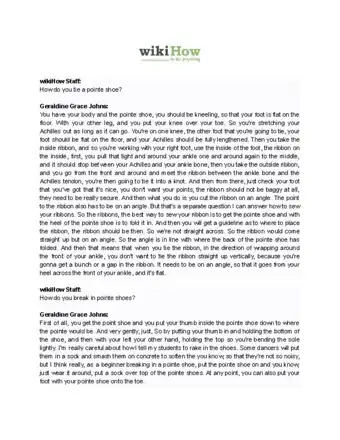
Thanks for reading our article! If you'd like to learn more about cleaning and repairing ballet shoes, check out our in-depth interview with Geraldine Grace Johns.
References
- ↑ https://www.liveabout.com/tips-for-cleaning-pointe-shoes-1006756
- ↑ https://www.danceadvantage.net/dance-gear-cleaning-tips/
- ↑ https://www.liveabout.com/tips-for-cleaning-pointe-shoes-1006756
- ↑ https://www.danceadvantage.net/dance-gear-cleaning-tips/
- ↑ https://youtu.be/d1A9agALI4g?t=72
- ↑ https://youtu.be/d1A9agALI4g?t=255
- ↑ https://youtu.be/d1A9agALI4g?t=135
- ↑ https://youtu.be/y0LImwdNpB8?t=129
- ↑ https://youtu.be/d1A9agALI4g?t=396
- ↑ https://youtu.be/d1A9agALI4g?t=183
- ↑ https://youtu.be/d1A9agALI4g?t=327
- ↑ https://youtu.be/d1A9agALI4g?t=364
- ↑ https://youtu.be/d1A9agALI4g?t=542
- ↑ https://youtu.be/y0LImwdNpB8?t=184
- ↑ https://youtu.be/d1A9agALI4g?t=391
- ↑ https://youtu.be/d1A9agALI4g?t=487
- ↑ https://youtu.be/d1A9agALI4g?t=443
- ↑ https://youtu.be/y0LImwdNpB8?t=256
- ↑ https://www.liveabout.com/tips-for-cleaning-pointe-shoes-1006756
- ↑ https://www.danceadvantage.net/dance-gear-cleaning-tips/
- ↑ https://www.pointemagazine.com/pointe-shoe-fitting-2412887873.html
- ↑ https://www.liveabout.com/tips-for-cleaning-pointe-shoes-1006756
- ↑ https://www.liveabout.com/tips-for-cleaning-pointe-shoes-1006756


